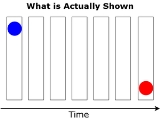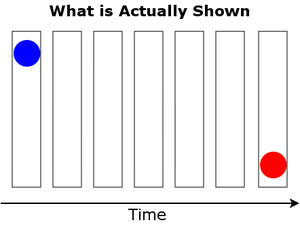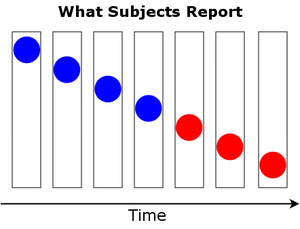
Color Phi phenomenon
Encyclopedia
The Color Phi phenomenon is a perceptual
illusion
described by psychologists Paul Kolers and Michael von Grunau in which a disembodied perception of motion
is produced by a succession of still images. The Color Phi phenomenon is a more complex variation of the Phi phenomenon
. Kolers and von Grunau originally investigated the phenomenon in response to a question posed by the philosopher Nelson Goodman
, who asked what the effect of the color change would have on the Phi phenomenon.
The classic color phi phenomenon experiment involves a viewer or audience watching a screen, upon which the experimenter projects two images in succession. The first image depicts a blue dot at the top of the frame. The second image depicts a red dot on the bottom of the frame. The images may be shown quickly, in rapid succession, or each frame may be given several seconds of viewing time. Once both images have been projected, the experimenter asks the viewer or audience to describe what they saw.
At certain combinations of spacing and timing of the two images, a viewer will report a sensation of motion in the space between two dots. The first spot will begin appear moving, and will then "change color abruptly in the middle of its illusory path".


Philosopher Daniel Dennett
utilizes the color phi phenomenon in his argument against a philosophy known as Cartesian materialism
.
Perception
Perception is the process of attaining awareness or understanding of the environment by organizing and interpreting sensory information. All perception involves signals in the nervous system, which in turn result from physical stimulation of the sense organs...
illusion
Illusion
An illusion is a distortion of the senses, revealing how the brain normally organizes and interprets sensory stimulation. While illusions distort reality, they are generally shared by most people....
described by psychologists Paul Kolers and Michael von Grunau in which a disembodied perception of motion
Motion (physics)
In physics, motion is a change in position of an object with respect to time. Change in action is the result of an unbalanced force. Motion is typically described in terms of velocity, acceleration, displacement and time . An object's velocity cannot change unless it is acted upon by a force, as...
is produced by a succession of still images. The Color Phi phenomenon is a more complex variation of the Phi phenomenon
Phi phenomenon
The phi phenomenon is an optical illusion defined by Max Wertheimer in the Gestalt psychology in 1912, in which the persistence of vision formed a part of the base of the theory of the cinema, applied by Hugo Münsterberg in 1916....
. Kolers and von Grunau originally investigated the phenomenon in response to a question posed by the philosopher Nelson Goodman
Nelson Goodman
Henry Nelson Goodman was an American philosopher, known for his work on counterfactuals, mereology, the problem of induction, irrealism and aesthetics.-Career:...
, who asked what the effect of the color change would have on the Phi phenomenon.
The classic color phi phenomenon experiment involves a viewer or audience watching a screen, upon which the experimenter projects two images in succession. The first image depicts a blue dot at the top of the frame. The second image depicts a red dot on the bottom of the frame. The images may be shown quickly, in rapid succession, or each frame may be given several seconds of viewing time. Once both images have been projected, the experimenter asks the viewer or audience to describe what they saw.
At certain combinations of spacing and timing of the two images, a viewer will report a sensation of motion in the space between two dots. The first spot will begin appear moving, and will then "change color abruptly in the middle of its illusory path".


Philosophical Significance
The existence of the color phi phenomenon poses an interesting philosophical problem. When asked to describe their experience, subjects report seeing the abrupt color change before the second dot is actually presented. However, logically, it is impossible for a subject to actually experience the color change before the second dot has been presented – how could the dot change color before the second dot is shown and the subject finds out what the color of the second dot is going to be?Philosopher Daniel Dennett
Daniel Dennett
Daniel Clement Dennett is an American philosopher, writer and cognitive scientist whose research centers on the philosophy of mind, philosophy of science and philosophy of biology, particularly as those fields relate to evolutionary biology and cognitive science. He is currently the Co-director of...
utilizes the color phi phenomenon in his argument against a philosophy known as Cartesian materialism
Cartesian materialism
In philosophy of mind, Cartesian materialism is the idea that at some place in the brain, there is some set of information that directly corresponds to our conscious experience...
.
External links
- An interactive demonstration of the color phi phenomenon.

